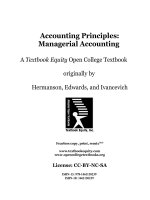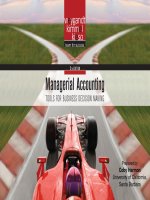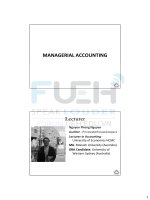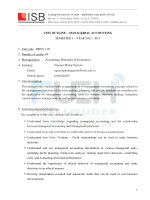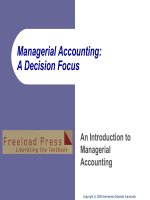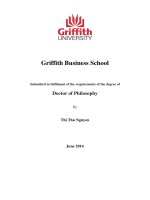MANAGERIAL ACCOUNTING
Bạn đang xem bản rút gọn của tài liệu. Xem và tải ngay bản đầy đủ của tài liệu tại đây (12.09 MB, 647 trang )
NINTH EDITION
Managerial
Accounting
This page intentionally left blank
NINTH EDITION
Susan V. Crosson, M.S. Accounting, C.P.A
Santa Fe College
Belverd E. Needles, Jr., Ph.D., C.P.A., C.M.A.
DePaul University
Managerial
Accounting
Managerial Accounting,
Ninth Edition
Susan Crosson, Belverd Needles
Vice President of Editorial, Business:
Jack W. Calhoun
Editor in Chief: Rob Dewey
Executive Editor: Sharon Oblinger
Supervising Developmental Editor:
Katie Yanos
Sr. Marketing Manager: Kristen Hurd
Marketing Coordinator: Heather Mooney
Sr. Marketing Communications Manager:
Libby Shipp
Content Project Manager: Darrell Frye
Media Editor: Bryan England
Editorial Assistant: Julie Warwick
Frontlist Buyer, Manufacturing: Doug Wilke
Production Service:
S4Carlisle Publishing Services
Sr. Art Director: Stacy Jenkins Shirley
Cover and Internal Designer: Grannan
Graphic Design
Cover Image: ©Getty Images/Image Bank
Permissions Account Manager: John Hill
© 2011, 2008 South-Western, Cengage Learning
Photo Credits: p. 3, Dorling Kindersley/Getty Images; p. 45, Caro/Alamy;
p. 91, Lori Adamski Peek /Workbook Stock/Getty Images; p. 129, Tim Boyle/Newsmakers/
Getty Images; p. 167, AP Photo/Carlos Osorio; p. 207, Ben Bloom/Getty images; p. 249,
Laura Doss/Fancy/PhotoLibrary; p.301, Ben Blankenburg/istockphoto; p. 345, UPI Photo/
Kevin Dietsch/Newscom; p. 393, Jupiterimages; p. 433, Monkey Business Images, 2009/
Used under license from Shutterstock.com; p. 471, AP Photo/Mark Lennihan; p. 517,
© Richard Levine/Alamy; p. 555 AP Photo/Martin Mejia
ALL RIGHTS RESERVED. No part of this work covered by the copyright herein may be
reproduced, transmitted, stored, or used in any form or by any means graphic, electronic,
or mechanical, including but not limited to photocopying, recording, scanning, digitizing,
taping, web distribution, information networks, or information storage and retrieval
systems, except as permitted under Section 107 or 108 of the 1976 United States
Copyright Act, without the prior written permission of the publisher.
For product information and technology assistance, contact us at
Cengage Learning Customer & Sales Support, 1-800-354-9706
For permission to use material from this text or product,
submit all requests online at www.cengage.com/permissions
Further permissions questions can be emailed to
ExamView
®
is a registered trademark of eInstruction Corp. Windows is a registered
trademark of the Microsoft Corporation used herein under license. Macintosh and Power
Macintosh are registered trademarks of Apple Computer, Inc. used herein under license.
© 2011 Cengage Learning. All Rights Reserved.
Cengage Learning WebTutor™ is a trademark of Cengage Learning.
Library of Congress Control Number: 2009943379
Student Edition ISBN 10: 0-538-74280-1
Student Edition ISBN 13: 978-0-538-74280-1
Instructors Edition ISBN 10: 0-538-74281-X
Instructors Edition ISBN 13: 978-0-538-74281-8
South-Western Cengage Learning
5191 Natorp Boulevard
Mason, OH 45040
USA
Cengage Learning products are represented in Canada by
Nelson Education, Ltd.
For your course and learning solutions, visit www.cengage.com
Purchase any of our products at your local college store or at our
preferred online store www.cengagebrain.com
Printed in the United States of America
1 2 3 4 5 6 7 14 13 12 11 10
v
1 The Changing Business Environment: A Manager’s Perspective 2
2 Cost Concepts and Cost Allocation 44
3 Costing Systems: Job Order Costing 90
4 Costing Systems: Process Costing 128
5 Value-Based Systems: ABM and Lean 166
6 Cost Behavior Analysis 206
7 The Budgeting Process 248
8 Performance Management and Evaluation 300
9 Standard Costing and Variance Analysis 344
10 Short-Run Decision Analysis 392
11 Capital Investment Analysis 432
12 Pricing Decisions, Including Target Costing and Transfer
Pricing
470
13 Quality Management and Measurement 516
14 Financial Analysis of Performance 554
APPENDIX A Present Value Tables 604
BRIEF CONTENTS
This page intentionally left blank
vii
Preface xv
About the Authors
xxix
CONTENTS
CHAPTER 1 The Changing Business Environment: A Manager’s Perspective 2
DECISION POINT Ǡ A MANAGER’S FOCUS WAL-MART
STORES, INC.
3
The Role of Management Accounting 4
Management Accounting and Financial Accounting:
A Comparison
4
Management Accounting and the Management
Process
5
Value Chain Analysis 11
Primary Processes and Support Services 12
Advantages of Value Chain Analysis 13
Managers and Value Chain Analysis 13
Continuous Improvement 15
Management Tools for Continuous
Improvement
16
Achieving Continuous Improvement 17
Performance Measures: A Key to Achieving
Organizational Objectives 19
Using Performance Measures in the Management
Process
19
The Balanced Scorecard 20
Benchmarking 22
Standards of Ethical Conduct 22
A LOOK BACK AT Ǡ WAL-MART STORES, INC. 25
STOP & REVIEW 27
CHAPTER ASSIGNMENTS 29
CHAPTER 2 Cost Concepts and Cost Allocation 44
DECISION POINT Ǡ A MANAGER’S FOCUS THE HERSHEY
COMPANY
45
Cost Information 46
Managers’ Use of Cost Information 46
Cost Information and Organizations 46
Cost Classifications and Their Uses 46
Cost Traceability 47
Cost Behavior 48
Value-Adding Versus Nonvalue-Adding
Costs
48
Cost Classifications for Financial Reporting 48
Financial Statements and the Reporting
of Costs 50
Income Statement and Accounting for
Inventories
50
Statement of Cost of Goods Manufactured 51
Cost of Goods Sold and a Manufacturer’s Income
Statement
53
Inventory Accounts in Manufacturing
Organizations 54
Document Flows and Cost Flows Through the
Inventory Accounts
54
The Manufacturing Cost Flow 56
Elements of Product Costs 58
Prime Costs and Conversion Costs 59
Computing Product Unit Cost 59
viii Contents
CHAPTER 3 Costing Systems: Job Order Costing 90
DECISION POINT Ǡ A MANAGER’S FOCUS COLD STONE
CREAMERY, INC.
91
Product Unit Cost Information and the
Management Process 92
Planning 92
Performing 92
Evaluating 92
Communicating 92
Product Costing Systems 93
Job Order Costing in a Manufacturing
Company 95
Materials 96
Labor 98
Overhead 98
Completed Units 99
Sold Units 99
Reconciliation of Overhead Costs 100
A Job Order Cost Card and the Computation
of Unit Cost 101
A Manufacturer’s Job Order Cost Card and the
Computation of Unit Cost
101
Job Order Costing in a Service Organization 102
A LOOK BACK AT Ǡ COLD STONE CREAMERY, INC. 105
STOP & REVIEW 107
CHAPTER ASSIGNMENTS 109
CHAPTER 4 Costing Systems: Process Costing 128
DECISION POINT Ǡ A MANAGER’S FOCUS DEAN
FOODS
129
The Process Costing System 130
Patterns of Product Flows and Cost Flow
Methods 131
Cost Flows Through the Work in Process Inventory
Accounts
132
Computing Equivalent Production 133
Equivalent Production for Direct Materials 134
Equivalent Production for Conversion Costs 135
Summary of Equivalent Production 135
Preparing a Process Cost Report Using the
FIFO Costing Method 136
Accounting for Units 136
Accounting for Costs 139
Assigning Costs 139
Process Costing for Two or More Production
Departments
141
Preparing a Process Cost Report Using the
Average Costing Method 143
Accounting for Units 143
Accounting for Costs 145
Assigning Costs 145
A LOOK BACK AT Ǡ DEAN FOODS 148
STOP & REVIEW 151
CHAPTER ASSIGNMENTS 153
Product Cost Measurement Methods 60
Computing Service Unit Cost 62
Cost Allocation 63
Allocating the Costs of Overhead 63
Allocating Overhead: The Traditional Approach 65
Allocating Overhead: The ABC Approach 67
A LOOK BACK AT Ǡ THE HERSHEY COMPANY 69
STOP & REVIEW 71
CHAPTER ASSIGNMENTS 74
Contents ix
CHAPTER 5 Value-Based Systems: ABM and Lean 166
DECISION POINT Ǡ A MANAGER’S FOCUS LA-Z-BOY,
INC.
167
Value-Based Systems and
Management 168
Value Chains and Supply Chains 169
Process Value Analysis 170
Value-Adding and Non-Value-Adding Activities 171
Value-Based Systems 171
Activity-Based Management 171
Managing Lean Operations 172
Activity-Based Costing 172
The Cost Hierarchy and the Bill of Activities 173
The New Operating Environment and Lean
Operations 176
Just-in-Time (JIT) 176
Continuous Improvement of the Work
Environment
178
Accounting for Product Costs in a JIT Operating
Environment
178
Backflush Costing 180
Comparison of ABM and Lean 184
A LOOK BACK AT Ǡ LA-Z-BOY, INC. 185
STOP & REVIEW 188
CHAPTER ASSIGNMENTS 190
CHAPTER 6 Cost Behavior Analysis 206
DECISION POINT Ǡ A MANAGER’S FOCUS FLICKR 207
Cost Behavior and Management 208
The Behavior of Costs 208
Mixed Costs and the Contribution Margin
Income Statement 214
The Engineering Method 214
The Scatter Diagram Method 214
The High-Low Method 215
Statistical Methods 217
Contribution Margin Income Statements 217
Cost-Volume-Profit Analysis 218
Breakeven Analysis 220
Using an Equation to Determine the Breakeven
Point
221
The Breakeven Point for Multiple Products 222
Using C-V-P Analysis to Plan Future Sales,
Costs, and Profits 225
Applying C-V-P to Target Profits 225
A LOOK BACK AT Ǡ FLICKR 228
STOP & REVIEW 231
CHAPTER ASSIGNMENTS 233
CHAPTER 7 The Budgeting Process 248
DECISION POINT Ǡ A MANAGER’S FOCUS FRAMERICA
CORPORATION
249
The Budgeting Process 250
Advantages of Budgeting 250
Budgeting and Goals 251
Budgeting Basics 251
The Master Budget 253
Preparation of a Master Budget 253
Budget Procedures 256
Operating Budgets 257
The Sales Budget 257
The Production Budget 258
The Direct Materials Purchases Budget 259
The Direct Labor Budget 261
x Contents
The Overhead Budget 261
The Selling and Administrative Expense
Budget
262
The Cost of Goods Manufactured Budget 263
Financial Budgets 265
The Budgeted Income Statement 265
The Capital Expenditures Budget 266
The Cash Budget 266
The Budgeted Balance Sheet 269
A LOOK BACK AT Ǡ FRAMERICA CORPORATION 271
STOP & REVIEW 274
CHAPTER ASSIGNMENTS 276
CHAPTER 9 Standard Costing and Variance Analysis 344
DECISION POINT Ǡ A MANAGER’S FOCUS iROBOT
CORPORATION
345
Standard Costing 346
Standard Costs and Managers 346
Computing Standard Costs 347
Standard Direct Materials Cost 347
Standard Direct Labor Cost 347
Standard Overhead Cost 348
Total Standard Unit Cost 349
Variance Analysis 350
The Role of Flexible Budgets in Variance
Analysis
350
Using Variance Analysis to Control Costs 352
Computing and Analyzing Direct Materials
Variances 355
Computing Direct Materials Variances 355
Analyzing and Correcting Direct Materials
Variances
357
CHAPTER 8 Performance Management and Evaluation 300
DECISION POINT Ǡ A MANAGER’S FOCUS VAIL
RESORTS
301
Performance Measurement 302
What to Measure, How to Measure 302
Other Measurement Issues 302
Organizational Goals and the Balanced
Scorecard
303
The Balanced Scorecard and Management 303
Responsibility Accounting 305
Types of Responsibility Centers 306
Organizational Structure and Performance
Management
308
Performance Evaluation of Cost Centers and
Profit Centers 310
Evaluating Cost Center Performance Using Flexible
Budgeting
310
Evaluating Profit Center Performance Using
Variable Costing
311
Performance Evaluation of Investment
Centers 313
Return on Investment 313
Residual Income 315
Economic Value Added 316
The Importance of Multiple Performance
Measures
318
Performance Incentives and Goals 319
Linking Goals, Performance Objectives, Measures,
and Performance Targets
319
Performance-Based Pay 320
The Coordination of Goals 320
A LOOK BACK AT Ǡ VAIL RESORTS 323
STOP & REVIEW 326
CHAPTER ASSIGNMENTS 328
Contents xi
Computing and Analyzing Direct Labor
Variances 358
Computing Direct Labor Variances 358
Analyzing and Correcting Direct Labor Variances 360
Computing and Analyzing Overhead
Variances 361
Using a Flexible Budget to Analyze Overhead
Variances
361
Computing Overhead Variances 362
Analyzing and Correcting Overhead
Variances
367
Using Cost Variances to Evaluate Managers’
Performance 369
A LOOK BACK AT Ǡ iROBOT CORPORATION 371
STOP & REVIEW 376
CHAPTER ASSIGNMENTS 378
CHAPTER 10 Short-Run Decision Analysis 392
DECISION POINT Ǡ A MANAGER’S FOCUS BANK OF
AMERICA
393
Short-Run Decision Analysis and the
Management Process 394
Incremental Analysis for Short-Run Decisions 394
Incremental Analysis for Outsourcing
Decisions 397
Incremental Analysis for Special Order
Decisions 399
Incremental Analysis for Segment
Profitability Decisions 402
Incremental Analysis for Sales Mix
Decisions 404
Incremental Analysis for Sell or Process-
Further Decisions 407
A LOOK BACK AT Ǡ BANK OF AMERICA 410
STOP & REVIEW 413
CHAPTER ASSIGNMENTS 415
CHAPTER 11 Capital Investment Analysis 432
DECISION POINT Ǡ A MANAGER’S FOCUS AIR PRODUCTS
AND CHEMICALS INC.
433
The Capital Investment Process 434
Capital Investment Analysis 434
Capital Investment Analysis in the Management
Process
435
The Minimum Rate of Return on Investment 437
Cost of Capital 437
Other Measures for Determining Minimum Rate of
Return
438
Ranking Capital Investment Proposals 438
Measures Used in Capital Investment
Analysis 439
Expected Benefits from a Capital Investment 439
Equal Versus Unequal Cash Flows 440
Carrying Value of Assets 440
Depreciation Expense and Income Taxes 440
Disposal or Residual Values 441
The Time Value of Money 442
Interest 442
Present Value 443
Present Value of a Single Sum Due
in the Future
444
Present Value of an Ordinary Annuity 444
The Net Present Value Method 446
Advantages of the Net Present Value Method 446
The Net Present Value Method Illustrated 446
Other Methods of Capital Investment
Analysis 449
The Payback Period Method 449
The Accounting Rate-of-Return Method 450
A LOOK BACK AT Ǡ AIR PRODUCTS
AND CHEMICALS INC.
452
STOP & REVIEW 454
CHAPTER ASSIGNMENTS 456
xii Contents
CHAPTER 13 Quality Management and Measurement 516
DECISION POINT Ǡ A MANAGER’S FOCUS AMAZON
.COM
517
The Role of Management Information
Systems in Quality Management 518
Enterprise Resource Planning Systems 518
Managers’ Use of MIS 518
Financial and Nonfinancial Measures
of Quality 520
Financial Measures of Quality 520
Nonfinancial Measures of Quality 521
Measuring Service Quality 525
Measuring Quality: An Illustration 526
Evaluating the Costs of Quality 526
Evaluating Nonfinancial Measures of Quality 529
The Evolving Concept of Quality 530
Recognition of Quality 532
A LOOK BACK AT Ǡ AMAZON.COM 534
STOP & REVIEW 536
CHAPTER ASSIGNMENTS 538
CHAPTER 12 Pricing Decisions, Including Target Costing
and Transfer Pricing 470
DECISION POINT Ǡ A MANAGER’S FOCUS LAB 126 471
The Pricing Decision and the Manager 472
Pricing Policies 472
Pricing Policy Objectives 472
Pricing and the Management Process 473
External and Internal Pricing Factors 473
Economic Pricing Concepts 475
Total Revenue and Total Cost Curves 475
Marginal Revenue and Marginal Cost Curves 477
Auction-Based Pricing 477
Cost-Based Pricing Methods 478
Gross Margin Pricing 479
Return on Assets Pricing 480
Summary of Cost-Based Pricing Methods 481
Pricing Services 482
Factors Affecting Cost-Based Pricing Methods 483
Pricing Based on Target Costing 485
Differences Between Cost-Based Pricing and Target
Costing
485
Target Costing Analysis in an Activity-Based
Management Environment
487
Pricing for Internal Providers of Goods
and Services 489
Transfer Pricing 489
Developing a Transfer Price 490
Other Transfer Price Issues 491
Using Transfer Prices to Measure Performance 491
A LOOK BACK AT Ǡ LAB 126 493
STOP & REVIEW 496
CHAPTER ASSIGNMENTS 498
Contents xiii
CHAPTER 14 Financial Analysis of Performance 554
DECISION POINT Ǡ A MANAGER’S FOCUS STARBUCKS
CORPORATION
555
Foundations of Financial Performance
Measurement 556
Financial Performance Measurement: Management’s
Objectives
556
Financial Performance Measurement: Creditors’ and
Investors’ Objectives
556
Standards of Comparison 557
Sources of Information 559
Executive Compensation 561
Tools and Techniques of Financial
Analysis 563
Horizontal Analysis 563
Trend Analysis 566
Vertical Analysis 567
Ratio Analysis 569
Comprehensive Illustration of Ratio
Analysis 571
Evaluating Liquidity 571
Evaluating Profitability 573
Evaluating Long-Term Solvency 574
Evaluating the Adequacy of Cash Flows 575
Evaluating Market Strength 577
A LOOK BACK AT Ǡ STARBUCKS CORPORATION 578
STOP & REVIEW 583
CHAPTER ASSIGNMENTS 585
APPENDIX A Present Value Tables 604
Endnotes 608
Company Index 610
Subject Index 612
This page intentionally left blank
PREFACE
Accounting
in Motion!
This revision of Managerial Accounting is based on an understanding of the
nature, culture, and motivations of today’s undergraduate students and on exten-
sive feedback from many instructors who use our book. These substantial changes
meet the needs of these students, who not only face a business world increasingly
complicated by ethical issues, globalization, and technology but who also have
more demands on their time. To assist them to meet these challenges, the authors
carefully show them how the effects of business transactions, which are the result
of business decisions, are recorded in a way that will be reflected on the finan-
cial statements. Instructors will find that building on the text’s historically strong
pedagogy, the authors have strengthened transaction analysis and its link to the
accounting cycle.
Updated Content,
Organization
and Pedagogy
Strong Pedagogical System
Managerial Accounting originated the pedagogical system of Integrated
Learning Objectives. The system supports both learning and teaching by provid-
ing flexibility in support of the instructor’s teaching of first-year accounting. The
chapter review and all assignments identify the applicable learning objective(s)
for easy reference.
Each learning objective refers to a specific content area, usually either con-
ceptual content or procedural techniques, in short and easily understandable seg-
ments. Each segment is followed by a “Stop and Apply” section that illustrates
and solves a short exercise related to the learning objective.
xv
& APPLY
STOP
Match the letter of each item below with the numbers of the related items:
a. An inventory cost
b. An assumption used in the valuation of
inventory
c. Full disclosure convention
d. Conservatism convention
e. Consistency convention
f. Not an inventory cost or assumed flow
____ 1. Cost of consigned goods
____ 2. A note to the financial statements
explaining inventory policies
____ 3. Application of the LCM rule
____ 4. Goods flow
____ 5. Transportation charge for mer-
chandise shipped FOB shipping
point
____ 6. Cost flow
____ 7. Choosing a method and sticking
with it
____ 8. Transportation charge for mer-
chandise shipped FOB destination
SOLUTION
1. f; 2. c; 3. d; 4. b; 5. a; 6. f; 7. e; 8. f
xvi Preface
To make the text more visually appealing and readable, it is divided into
student-friendly sections with brief bulleted lists, new art, photographs, and end-
of-section review material.
Further, to reduce distractions, the margins of the text include only Study
Notes, which alert students to common misunderstandings of concepts and tech-
niques; key ratio and cash flow icons, which highlight discussions of profitability
and liquidity; and accounting equations.
In this edition, we reduced excessive detail, shortened headings, simplified
explanations, and increased readability in an effort to reduce the length of each
chapter.
To avoid financial distress, a company must be able to pay its bills on time. Because
the timing of cash flows is critical to maintaining adequate liquidity to pay bills,
managers and other users of financial information must understand the difference
between transactions that generate immediate cash and those that do not. Con-
sider the transactions of Miller Design Studio shown in Figure 2-3. Most of them
involve either an inflow or outflow of cash.
As you can see in Figure 2-3, Miller’s Cash account has more transactions
than any of its other accounts. Look at the transactions of July 10, 15, and 22:
Ǡ July 10: Miller received a cash payment of $2,800.
Ǡ July 15: The firm billed a customer $9,600 for a service it had already per-
formed.
Ǡ July 22: The firm received a partial payment of $5,000 from the customer,
but it had not received the remaining $4,600 by the end of the month.
Because Miller incurred expenses in providing this service, it must pay careful
attention to its cash flows and liquidity.
One way Miller can manage its expenditures is to rely on its creditors to give
it time to
p
a
y
. Com
p
are the transactions of
J
ul
y
3
,
5
,
and 9 in Fi
g
ure 2-3.
Cash Flows
and the Timing
of Transactions
LO5 Show how the timing
of transactions affects cash
flows and liquidity.
Enhanced Real-
World Examples
Demonstrate
Accounting
in Motion
IFRS, Fair Value, and Other Updates
International Financial Reporting Standards and fair value have been integrated
throughout the book where accounting standards have changed and also in the
Business Focus features where applicable. All current events, statistics, and tables
have been updated with the latest data.
Study Note
After Step 1 has been completed,
the Income Summary account
reflects the account balance of
the Design Revenue account
before it was closed.
Preface xvii
Use of Diverse Companies
Each chapter begins with a Decision Point, a real-world scenario about a
company that challenges students to see the connection between accounting
information and management decisions.
FOCUS ON BUSINESS PRACTICE
IFRS: The Arrival of International Financial Reporting Standards in the United States
and Exchange Commission (SEC) recently voted to
allow foreign registrants in the United States. This
is a major development because in the past, the
SEC required foreign registrants to explain how the
standards used in their statements differed from
U.S. standards. This change affects approximately 10
percent of all public U.S. companies. In addition, the
SEC may in the near future allow U.S. companies to
use IFRS.
11
Over the next few years, international financial
reporting standards (IFRS) will become much more
important in the United States and globally. The
International Accounting Standards Board (IASB)
has been working with the Financial Accounting
Standards Board (FASB) and similar boards in other
nations to achieve identical or nearly identical stan-
dards worldwide. IFRS are now required in many
parts of the world, including Europe. The Securities-
Ǡ An order for airplanes is
obviously an important
economic event for both the
buyer and the seller. Is there a
difference between an economic
event and a business transaction
that should be recorded in the
accounting records?
Ǡ Should Boeing record the order
in its accounting records?
Ǡ How important are liquidity and
cash flows to Boeing?
DECISION POINT
Ǡ
A USER’S FOCUS
THE BOEING COMPANY
In April 2006, the Chinese government announced that it had ordered
80
Boeing commercial jet liners, thus fulfilling a commitment it
had made to purchase 150 airplanes from Boeing. Valued at about
$4.6 billion, the order for the 80 airplanes was one of many events
that brought about Boeing’s resurgence in the stock market. After
Boeing received this order, as well as orders from other customers,
its stock began trading at an all-time high.
Typically, it takes Boeing almost two years to manufacture an
airplane. In this case, the aircraft delivery cycle was expected to peak
in 2009.
1
These company examples come full circle at the end of the chapter by linking
directly to the A Look Back At diverse company examples illustrate accounting
concepts and encourage students to apply what they have learned.
A LOOK BACK AT
Ǡ
THE BOEING COMPANY
The Decision Point at the beginning of the chapter described the order for 80 airplanes
that the Chinese government placed with Boeing. It posed the following questions:
• An order for airplanes is obviously an important economic event to both the buyer
and the seller. Is there a difference between an economic event and a business
transaction that should be recorded in the accounting records?
• Should Boeing record the order in its accounting records?
• How important are liquidity and cash flows to Boeing?
Despite its importance, the order did not constitute a business transaction, and nei-
ther the buyer nor the seller should have recognized it in its accounting records. At the
time the Chinese government placed the order, Boeing had not yet built the airplanes.
Until it delivers them and title to them shifts to the Chinese government, Boeing cannot
record any revenue.
xviii Preface
CVS Caremark Corporation
Consolidated Statements of Operations
Fiscal Year Ended
Dec. 31, 2008 Dec. 29, 2007 Dec. 30, 2006
(In millions, except per share amounts) (52 weeks) (52 weeks) (53 weeks)
Net revenues $87,471.9 $76,329.5 $43,821.4
Cost of revenues 69,181.5 60,221.8 32,079.2
Gross profit 18,290.4 16,107.7 11,742.2
Total operating expenses 12,244.2 11,314.4 9,300.6
Operating profit
1
6,046.2 4,793.3 2,441.6
Interest expense, net
2
509.5 434.6 215.8
Earnings before income tax provision 5,536.7 4,358.7 2,225.8
Loss from discontinued operations, (132) — —
net of income tax benefit of $82.4
Income tax provision 2,192.6 1,721.7 856.9
Net earnings
3
3,212.1 2,637.0 1,368.9
Preference dividends, net of income tax benefit
4
14.1 14.2 13.9
Net earnings available to common shareholders $ 3,198.0 $ 2,622.8 $ 1,355.0
BASIC EARNINGS PER COMMON SHARE:
5
Net earnings $ 2.23 $ 1.97 $ 1.65
Weighted average common shares outstanding 1,433.5 1,328.2 820.6
DILUTED EARNINGS PER COMMON SHARE:
Net earnings $ 2.18 $ 1.92 $ 1.60
Weighted average common shares outstanding 1,469.1 1,371.8 853.2
Consolidated means that data from all
companies owned by CVS are combined.
CVS’s fiscal year ends on the Saturday
closest to December 31.
Revised and Expanded Assignments
Assignments have been carefully scrutinized for direct relevancy to the learning
objectives in the chapters. Names and numbers for all Short Exercises, Exercises,
and Problems have been changed except those used on videos. We have reversed
the alternate and main problems from the previous edition. Most importantly,
alternative problems have been expanded so that there are ample problems for
any course.
All of the cases have been updated as appropriate and the number of cases in
each chapter has been reduced in response to user preferences. The variety of cases
in each chapter depends on their relevance to the chapter topics, but throughout
the text there are cases involving conceptual understanding, ethical dilemmas,
interpreting financial reports, group activities, business communication, and the
Internet. Annual report cases based on CVS Caremark and Southwest Airlines
can be found at the end of the chapter.
Use of Well-Known Public Companies
This textbook also offers examples from highly recognizable public companies,
such as CVS Caremark, Southwest Airlines, Dell Computer, and Netflix, to relate
basic accounting concepts and techniques to the real world. The latest available
data is used in exhibits to incorporate the most recent FASB pronouncements.
The authors illustrate current practices in financial reporting by referring to data
from Accounting Trends and Techniques (AICPA) and integrate international top-
ics wherever appropriate.
Preface xix
Specific Chapter Changes
The following chapter-specific changes have been made in this edition of
Managerial Accounting:
Chapter 1 The Changing Business Environment: A Manager’s Perspective
• Updated definition of management accounting in LO1
• Lean production introduced as a key term in LO3
• Sections on total quality management and activity based management in LO3
revised
• Updated Focus on Business Practice box on how to blow the whistle on fraud
Chapter 2 Cost Concepts and Cost Allocation
• New company (Hershey’s) used as example in the Decision Point
• Discussions of costs in LO2 in previous edition incorporated in LO1
• Introduction to methods of product cost measurement added and section on
computing service unit cost shortened in new LO4
• LO7 and LO8 in previous edition (the traditional and ABC approaches to
allocating overhead) streamlined and incorporated in new LO5
Chapter 3 Costing Systems: Job Order Costing
• Chapter 3 in previous edition separated into two chapters, with new
Chapter 3 focusing on job order costing and new Chapter 4 focusing on
process costing
• Operations costing system introduced as a key concept
• Discussions of manufacturer’s job order cost card, computation of unit cost,
and job order costing in a service organization included in new LO4
Chapter 4 Costing Systems: Process Costing
• New chapter (part of Chapter 3 in previous edition)
Chapter 5 Value-Based Systems: ABM and Lean
• Chapter revised to emphasize value-based systems
• LO1, LO2, and LO3 in last edition revised and incorporated in new LO1
• New listing of the disadvantages of activity-based costing in LO2
• New focus on lean operations in LO3 and section on accounting for product
costs added
Chapter 6 Cost Behavior Analysis
• New company (Flickr) used as example in the Decision Point
• Sections on variable, fixed, and mixed costs, which were in LO2 in last edi-
tion, now included in LO1
• Concept of a step cost introduced in discussion of fixed costs in LO1
• Methods used to separate the components of mixed costs and the contribu-
tion margin income statement now the focus of LO2
• Material in LO4 reformatted to clarify concepts
xx Preface
Chapter 7 The Budgeting Process
• New company (Framerica Corporation) used as example in the Decision
Point
• LO1 reorganized, revised, and shortened
• Section on advantages of budgeting and three new key terms—static budget,
continuous budget, and zero-based budgeting added to LO1
Chapter 8 Performance Management and Evaluation
• LO1 and LO2 in last edition combined and revised
Chapter 9 Standard Costing and Variance Analysis
• New company (iRobot Corporation) used as example in the Decision Point
• LO1 and LO2 in last edition combined and revised
• New Focus on Business Practice box titled “What Do You Get When You
Cross a Vacuum Cleaner with a Gaming Console?”
Chapter 10 Short-Run Decision Analysis
• Chapter revised to focus on the use of incremental analysis in making short-
run decisions; capital investment analysis and time value of money now cov-
ered in Chapter 11
Chapter 11 Capital Investment Analysis
• New chapter
Chapter 12 Pricing Decisions, Including Target Costing and Transfer
Pricing
• LO1 reorganized and shortened
• Updated Focus on Business Practice box on Internet fraud
• Discussions of steps followed in gross margin pricing and return on assets
pricing in LO3 reformatted for greater clarity
• Discussion of the differences between cost-based pricing and target costing in
LO4 revised and made more succinct
• Section on developing a transfer price in LO5 revised
Preface xxi
Chapter 13 Quality Management and Measurement
• In LO2, formula for computing delivery cycle time added and displayed;
formula for computing waste time also displayed
• In LO4, discussion of Motorola’s Sigma Six quality goal revised, with
disadvantages noted
Chapter 14 Financial Analysis of Performance
• Section on the management process in LO1 revised to increase the focus on
management’s objectives
• Revised Focus on Business Practice box on pro forma earnings
• In LO3, two-year coverage of the comprehensive ratio analysis extended to
three years
• Revised Focus on Business Practice box on performance measurement and
management compensation
xxii Preface
South-Western, a division of Cengage Learning, offers a vast array of online solu-
tions to suit your course and your students’ learning styles. Choose the product
that best meets your classroom needs and course goals. Please check with your
sales representative for more details and ordering information.
CengageNOW™
CengageNOW for Crosson/Needles Managerial Accounting, 9e is a powerful and
fully integrated online teaching and learning system that provides you with flexibil-
ity and control. This complete digital solution offers a comprehensive set of digital
tools to power your course. CengageNOW offers the following:
Ǡ Homework, including algorithmic variations
Ǡ Integrated e-book
Ǡ Personalized study plans, which include a variety of multimedia assets (from
exer
cise demonstrations to videos to iPod content) for students as they master
the chapter materials
Ǡ
Assessment options, including the full test bank and algorithmic variations
Ǡ Reporting capability based on AACSB, AICPA, and IMA competencies and
standards
Ǡ
Course Management tools, including grade book
Ǡ WebCT and Blackboard Integration
Visit www.cengage.com/tlc for more information.
WebTutor™ on Blackboard
®
and WebCT™
WebTutor™ is available packaged with Crosson/Needles Managerial Account-
ing, 9e or for individual student purchase. Jump-start your course and customize
rich, text-specific content with your Course Management System.
Ǡ Jump-start: Simply load a W
ebT
utor cartridge into your Course Manage-
ment System.
Ǡ Customize content: Easily blend, add, edit, reor
ganize, or delete content.
Content includes media assets, quizzing, test bank, web links, discussion top-
ics, interactive games and exercises, and more.
Visit www.cengage.com/webtutor for more information.
Teaching Tools
for Instructors
Ǡ Instructor’s Resource CD-ROM: Included on this CD set are the key sup-
plements designed to aid instructors, including the Solutions Manual, Exam-
View Test Bank, Word Test Bank, and Lecture PowerPoint slides.
Ǡ Solutions Manual: The Solutions Manual contains answers to all exer
cises,
problems, and activities that appear in the text. As always, the solutions are
author-written and verified multiple times for numerical accuracy and consis-
tency with the core text.
Ǡ ExamView
®
Pro Testing Software: This intuitive softwar
e allows you to
easily customize exams, practice tests, and tutorials and deliver them over a
network, on the Inter
net, or in printed form. In addition, ExamView comes
with searching capabilities that make sorting the wealth of questions from the
printed test bank easy. The software and files are found on the IRCD.
Online Solutions
for Every Learning
Style
Preface xxiii
Ǡ Lecture PowerPoint
®
Slides: Instructors will have access to PowerPoint
slides online and on the IRCD. These slides are conveniently designed around
learning objectives for partial chapter teaching and include art for dynamic
presentations. There are also lecture outline slides for each chapter for those
instructors who prefer them.
Ǡ Instructor’s Companion Website: The instr
uctor website contains a vari-
ety of r
esources for instructors, including the Instructor’s Resource Manual
(which has chapter planning matrices, chapter resource materials and out-
lines, chapter reviews, difficulty and time charts, etc.), and PowerPoint slides.
www.cengage.com/accounting/needles
Ǡ Klooster &
Allen’s General Ledger Software: Pr
epared by Dale Klooster
and Warren Allen, this best-selling, educational, general ledger package
introduces students to the world of computerized accounting through a
more intuitive, user-friendly system than the commercial software they will
use in the future. In addition, students have access to general ledger files
with information based on problems from the textbook and practice sets.
This context allows them to see the difference between manual and com-
puterized accounting systems firsthand. Also, the program is enhanced
with a problem checker that enables students to determine if their entries
are correct. Klooster & Allen emulates commercial general ledger pack-
ages more closely than other educational packages. Problems that can be
used with Klooster/Allen are highlighted by an icon. The Inspector Files
found on the IRCD allow instructors to grade students’ work. A free Net-
work Version is available to schools whose students purchase Klooster/
Allen’s General Ledger Software.
Learning
Resources for
Students
CengageNOW™
CengageNOW for Crosson/Needles Managerial Accounting, 9e is a powerful and
fully integrated online teaching and learning system that provides you with flexibil-
ity and control. This complete digital solution offers a comprehensive set of digital
tools to power your course. CengageNOW offers the following:
Ǡ Homework, including algorithmic variations
Ǡ Integrated e-book
Ǡ Personalized study plans, which include a variety of multimedia assets (from
exer
cise demonstrations to videos to iPod content) for students as they master
the chapter materials
Ǡ
Assessment options, including the full test bank and algorithmic variations
Ǡ Reporting capability based on AACSB, AICPA, and IMA competencies and
standards
Ǡ
Course Management tools, including grade book
Ǡ WebCT and Blackboard Integration
Visit www.cengage.com/tlc for more information.
xxiv Preface
WebTutor™ on Blackboard
®
and WebCT™
Ǡ WebTutor™ is available packaged with Crosson/Needles Managerial Account-
ing, 9e or for individual student purchase. Jump-start your course and cus-
tomize rich, text-specific content with your Course Management System.
Ǡ Jump-start: Simply load a W
ebTutor cartridge into your Course Manage-
ment System.
Ǡ Customize content: Easily blend, add, edit, reor
ganize, or delete content.
Content includes media assets, quizzing, test bank, web links, discussion top-
ics, interactive games and exercises, and more.
Visit www.cengage.com/webtutor for more information.
Klooster & Allen’s General Ledger Software: This best-selling, educational,
general ledger software package introduces you to the world of computerized
accounting through a more intuitive, user-friendly system than the commercial
software you’ll use in the future. Also, the program is enhanced with a problem
checker that provides feedback on selected activities and emulates commercial
general ledger packages more closely than other educational packages. Problems
that can be used with Klooster/Allen are highlighted by an icon.
Working Papers (Printed): A set of preformatted pages allow students to more
easily work end-of-chapter problems and journal entries.
Student CD-ROM for Peachtree
®
: You will have access to Peachtree so you can
familiarize yourself with computerized accounting systems used in the real world.
You will gain experience from working with actual software, which will make you
more desirable as a potential employee.
Electronic Working Papers in Excel
®
Passkey Access (for sale online): Students
can now work end-of-chapter assignments electronically in Excel with easy-to
follow, preformatted worksheets. This option is available via an online download
with a passkey.
Companion Website: The student website contains a variety of educational
resources for students, including online quizzing, the Glossary, Flashcards, and
Learning Objectives.
www.cengage.com/accounting/needles
